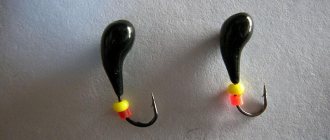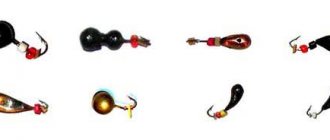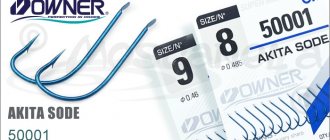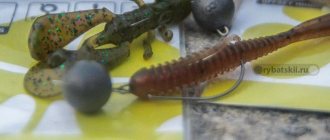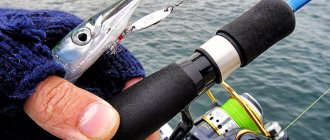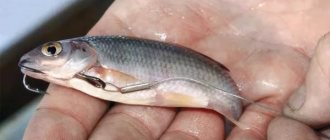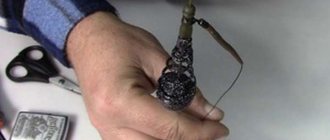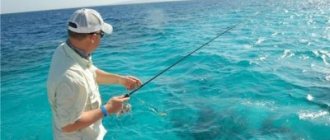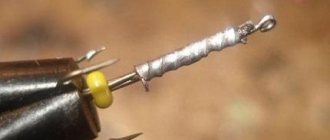Yuri 07.12.2020 2988
Self-snapping or self-striking hooks in fishing are not new. They appeared quite a long time ago and are used in almost all types of fishing. But not everyone knows how to use them. Based on my experience, I decided to share theoretical information, observations, and also talk about the types of self-hooks and their differences.
Basic criteria for choosing the best hook for bream
When choosing the best hook for bream, you must adhere to the following basic criteria:
- Select according to the nozzle.
- Choose only high-quality material that will be durable.
- Keep an eye on the sharpness. The blunter the hook, the greater the chance of not catching a catch.
- Choose the right size.
- Take into account the thickness of the hook and its color - it is necessary to select it according to the bait used.
- Choose depending on the different fishing conditions, including the fishing gear used.
- Pay attention to the manufacturer.
An important point: for fishing you need several hooks that differ in size, color, and shape.
Hook shape
The amount of catch directly depends on the shape of the hook, which allows:
- carry out cutting at the proper level;
- make a good grab.
The forms come in the following types:
- Classic with a round bend. There are subtypes of the sting: straight, in the other direction or inward. These forms are chosen when fishing with bait of plant origin, which hold relatively weakly on the hook, and also when you need to make a long cast. Suitable for any gear.
- The flat or so-called flattened shape is used if the bait is worms, bloodworms, corn, dough, etc. Selected mainly for spinning fishing rods.
- With an extended fore-end , as well as grooves. Ideal for fishing with worms.
- Special "bream". They do not carry any unique features, are suitable for everything and are more often used by beginners due to their name.
The main thing when choosing is to rely on specific circumstances, bait, gear used, as well as personal preferences.
Material of manufacture
The material for the hooks is a specialized and very strong wire, which varies in steel:
- regular and high-carbon - very reliable and practical. However, a protective layer against corrosion should be applied;
- Stainless steel is the most expensive material. But it is not only practical, but also resistant to corrosion.
Acuity
The most important indicator is the sharpness of the hook. Depends on:
- cutting quality. A hook that is not sharp enough gives a greater opportunity for bream to jump off it;
- abundance of catch. So, if the hook is poorly sharpened, then catching a fish, even under ideal conditions, will be more difficult;
- nature of the hook.
When fishing, you need to check for sharpness regularly; it is advisable to do it every time you cast, especially if it concerns:
- areas with a rocky or muddy reservoir bottom;
- when feeder fishing.
You can check the sharpness of the hook in the following ways:
- Thorough visual inspection.
- Hold the hook with your hand, pointing down, and slide it over your nail. With this option, the point should cling to the nail plate, but with a blunt one, on the contrary, it should slide easily.
- Touch with the pad of your finger. If noticeable pain and pricking are observed, the hook can be continued to be used.
Hook size
The main rule when choosing a hook size is to take into account the approximate weight of the future fish, as well as the bait that will be used when fishing.
Practice shows that any size can produce a rich catch if you follow the basic rules:
- with bait such as yellow and red worms, it is better to give preference to numbers 6–10;
- when fishing with corn, porridge, bread and other vegetable baits, medium sizes numbered 8–14 will be ideal;
- when using several maggots - No. 10–14;
- when using bloodworms - No. 14–16;
- Fishing using foam requires increasing the size by at least two positions.
Important advice: you should purchase hooks of different sizes so that, if necessary, you can replace them during the fishing process.
Moreover, each fisherman has his own preferences in this matter; many believe that the catch with a small hook will be more successful than with a large one, and vice versa.
Pros of using a small hook:
- possibility of thorough camouflage using attachments;
- the likelihood that the bream will not notice it and will pay attention to the bait is higher;
- will be able to swallow the hook entirely, and as a result, escape is impossible.
The disadvantages of the small size include the possibility of poor hooking, especially with hard baits.
Pros of a large hook size:
- other small fish of no interest will not bite;
- It is much more difficult for bream to escape.
The downside of a large size is its visibility, and since bream is a cautious fish, this can make catching difficult.
Hook thickness
Features of hook thickness when fishing for bream:
- with a thin hook, there is minimal damage to the bait;
- in summer, bream is more likely to cut its lip with a small wire diameter, since the fish’s resistance is high;
- In winter, bream are passive and can be of any thickness.
Color
The color of the hook plays a huge role in catching bream. Key points when choosing the right color:
- Select based on the bait used:
- White - used when fishing with bread or dough.
- Green, blue, burgundy and other dark colors - for worms, caterpillars, maggots.
- Red - for bloodworms.
- Yellow or golden - for corn.
- Pay attention to the coating:
- Light or dark nickel coating protects the hook from constant exposure to water;
- Varnished, the most short-lived, as a rule, for one or two fishing trips.
Examples of gear used: self-cutting fishing hooks
Roller-type equipment for pike fishing
Despite the fact that self-cutting hooks are more common when catching peaceful fish of the carp family, an example can be given of how to use them when catching a predator, such as pike, perch, pike perch or burbot. For this purpose, a “skating rink” type tackle is used.
The design of this fishing tool is simple and consists of the following elements:
- float-cylinder made of hard foam 18 cm in length and 6 cm in diameter and a cut for fastening the fishing line in the end part;
- fishing line of the required length, wound in the center of the float;
- olive shaped sinker;
- retractable leashes on carabiners, equipped with self-locking hooks.
We recommend reading: Sharpeners for fishing hooks, their manufacture and use
The principle of fishing with such gear is similar to fishing with mugs, but has the advantage that it works even in windy weather. The sinker creates enough tension so that with a sharp jerk the predator sits on the hook. After fishing, the leash with the fish is unfastened from the main fishing line, replaced with a new one, and fishing continues.
Feeder self-cutting tackle
There are three options for using self-cutting tackle together with a feeder, although they are only suitable for reservoirs with standing water.
First option. It is the most popular and is actually a paternoster equipped with a short leash, the difference being the sinker, which changes to a weighted swim feeder. In this design, the fishing gear works very effectively when hunting roach, practically eliminating empty bites. The length of the leash is about half a meter, and the weight of the feeder is 50 grams; it is filled with animal bait. After casting, the line is tightened and a heavy bite alarm is installed.
Second option. Unlike the first option, this equipment consists of more elements:
- main line with a size 18 feeder attached to it;
- a leash with a self-closing hook is fastened from the feeder at a distance of half a meter;
- at the very end of the tackle a bombard weighing 50 grams is installed.
It is important to remember that with such heavy equipment, hooking is not only not required, but is generally dangerous, since it can lead to breakage of the working line. Notching and fishing are done smoothly and slowly, slightly reeling in the line.
Since the feeders have a considerable mass, to cast them, the tensile strength of the fishing line must be at least 3 kg. To protect the working leash with a strength of 1 kg, a spacer made of durable elastic material is used, which acts as a shock absorber.
Third option. This option is justified when fishing for carp. A large feeder feeder is attached to the end of the main line, and a self-cutting fishing hook is mounted just above it, on a very short leash.
The fishing technique is to fill the feeder with bait until a dense ball is formed. A hook is inserted into this ball, on which bait is pre-attached and camouflaged. The careful fish does not notice the line of the leash and begins to eat the bait with appetite, among which bait with a hook appears unnoticed. When the fish senses danger and suddenly swims to the side, it will hook itself. Using this method, the largest and most cautious carp are caught.
Do-it-yourself self-cutting tackle
- It is necessary to prepare diverting leashes with special hooks, a weight or feeder with a mass calculated from the mass of the expected fish caught, as well as accessories in the form of swivels, carabiners, shock absorbers and beads.
- The next step is to tie the swivel to the leash, and attach it to the main fishing line using a link from a carabiner with a bead and a shock-absorbing cambric.
- At the last stage, it is necessary to tie a feeder or a weight corresponding to the type of fishing to the end of the fishing line.
It should also be remembered that it is always necessary to adjust the drag on the reel if there is a lot of hiding place for fish in the reservoir. The rod must always be visible and within reach in order to exercise control over it. It is advisable to place it in your hand or a special holder, otherwise a large individual may drag it into the water with it, since a fish caught on a self-sustaining hook will no longer be able to get off it.
Features of choosing a hook
Depending on fishing conditions
Peculiarities:
- when fishing in a reservoir with a rocky or muddy day, the hook must be used with the sharpest possible tip;
- in the winter season, it is more advisable to fish with a hook number 14, it will allow you to make a good hook;
- in autumn it is better to fish with thin hooks;
- In spring and autumn it is better to use stronger ones, since bream is very active and, otherwise, may break off.
Depending on the gear used
Basic moments:
- when using a feeder, the hooks should allow you to easily hook the bream, even at the moment of incomplete swallowing of the bait, in other words, while the fish is trying it. It is better to use round ones;
- When using spinning gear, it is recommended to use hooks with a long shank and barb to catch bream. Here it is possible to plant several worms at once, which increases the chances of catching;
- When using a float in fishing, you should give preference to an elongated, as strong and durable hook as possible, which is also suitable for long-distance casting. It holds bait excellently.
How to increase your fish catch? ">
Over 7 years of active fishing, I have found dozens of ways to improve the bite. Here are the most effective ones:
- Bite activator . This pheromone additive attracts fish most strongly in cold and warm water. Discussion of the bite activator “Hungry Fish”.
- Increased gear sensitivity. Read the appropriate manuals for your specific type of gear.
- Pheromone -based lures .
Choosing hooks for feeder fishing
Just a couple of decades ago, a good fishing hook was in short supply, and there was no need to talk about careful selection; fishermen used what they could “get.”
Nowadays there are no such problems and every fishing store offers a significant assortment of hooks that differ in:
- form;
- size;
- weight;
- configurations;
- manufacturing materials;
- blossom.
Most anglers purchase feeder hooks for different fishing conditions, and the right choice increases the chances that the fishing will be successful. But a large assortment also has a downside, because it is more difficult to figure out which hook will show the desired result on the pond and provide convenience while fishing.
Hooks for the feeder must be sharp and effectively “cut” the fish’s lip when biting. Hooks made of thick wire are more reliable, but they repel small fish and the hook is worse than when using a thin hook. So when choosing, you need a reasonable combination of wire thickness (power) and hook notching, in this case you will be confident in your installations.
In addition, hooks for successful feeder fishing are selected to match the bait because, for example, a thick hook will not pierce maggots or bloodworms, which are used as bait. The bait on the hook should look natural so as not to scare away the fish and provoke it to bite.
Therefore, when fishing with animal baits, choose feeder hooks made of thin wire in size corresponding to the size of the bait. Agree that one maggot on a large and thick hook looks unnatural, and it’s not so easy to put it on.
And even soft canned corn is used with thin wire hooks that easily pierce and retain the shape of the bait. When using a dung or earthworm as bait, you need a hook with a long shank, because it is difficult to put such a bait on a small hook.
The best hooks for a picker or feeder have a minimum weight, which ensures a natural supply of bait and its “play” in the water column.
A light and durable hook is the dream of feeder fishing lovers and therefore their preferences are on the side of such manufacturers as:
- Owner.
- Gamakatsu.
- Preston.
- Kamasan.
- Korum.
- Drennan.
These companies specialize in the production of hooks for feeder fishing, although most of them do not have their own facilities for such purposes. China is now the leading manufacturer, including hooks for feeder fishing.
European companies place their orders with Chinese enterprises, and their specialists control the quality of their products so that they meet international standards. We regret to say that there are many counterfeits of popular brands on the market, and before purchasing, it is advisable to make sure that you are purchasing a truly authentic product.
Each package of hooks from popular brands indicates:
- Name;
- hook number;
- The diameter of the wire;
- color;
- hook type;
- the presence of an ear or blade;
- number of hooks;
- barcode of the country of origin.
In one article there is no point in dwelling on specific models of hooks, especially since these companies have a very large assortment. The main thing is to understand the principles of choosing hooks, because each body of water has its own characteristics and corresponding ichthyofauna.
When catching small fish with miniature baits, the smallest and lightest hooks are selected; if we are talking about crucian carp, bream, or carp, then the size and thickness of the hooks increase.
Feeder athletes begin fishing with small hooks and, as necessary and when sorting out baits, increase their size.
Important! Choose hooks with a point bent to the side, this improves the hook and the fish will not come off the hook.
Manufacturers of bream hooks
When choosing the best hooks for bream, you should pay attention to its manufacturer, because otherwise, you may run into poor quality material. Currently, there are no worthy competitors to Western suppliers on the market among domestic companies engaged in the production of fishing tackle and equipment. Today there are the most trusted and famous Japanese brands in this industry:
Kamasan is a well-known manufacturer and today is a sales leader. They offer universal and very reliable hooks, mainly specializing in very light and stainless wire.
The best models for bream:
- Kamasan B525 – with a ring, perfect for float fishing. Universal for any bait.
- Kamasan B532 - made of very thin and durable material. They are best used for fishing with a worm or maggot, suitable for a feeder.
Gamakatsu has been on the market for over fifty years and has gained great recognition during this time. They mainly offer hooks for feeder fishing. Their feature, in addition to durable wire, is the very high grip of the product, which retains its sharpness for a long time. Excellent for baits such as worms.
The best models for bream:
- Gamakatsu LS-1010B – ideal thickness and the ability to attach various baits that will not fall off during the current. They have a special coating.
- The Gamakatsu LS-1040R is excellent for feeder fishing and also has a long shank and is perfect for baits such as worms.
Owner has been successfully producing various fishing gear and equipment for forty years. There is a patented method for sharpening hooks, which allows the product not to lose its sharpness for a long time.
The best models for bream:
- Owner 50152 – high quality, best for feeder fishing with any bait.
- Owner 50152 – used primarily on a float, ideal for plant baits.
An important point: you should not try to save on hooks and buy a cheaper option.
Selecting a hook for crucian carp
A good fisherman always has hooks of different sizes and shapes in his inventory. To catch crucian carp, experienced fishermen advise using hooks from numbers 18 to 10 (according to the accepted world numbering).
Hook components:
- head;
- forend;
- prying;
- sting with grooves.
What should the hook be?
- small size;
- lasting;
- black color;
- beard with notches;
- sting with a bend inward;
- round.
The mouth of the crucian carp is quite small, because of this it does not swallow the hook deeply; more often it is simply caught by the tip of its lip.
If you fish with a float rod, use thin hooks and a straight tip. For bottom fishing - with an internal bend of the tip. It is much more difficult for Karas to free himself from such a notch.
Nuances of choice
You need to know the feeding habits of fish in order to choose the right bait for crucian carp. Depending on the distance at which you have to fish and the type of bait, hooks are selected as follows:
- for fishing for bloodworms, a hook No. 18 is suitable, thin with a non-curved sting, and the method of fishing is unimportant;
- if the bait is maggot , dough or porridge balls, so that it does not fly off, take a larger hook - No. 16 or 14, with a small spring wound around the shank.
- For a worm, crucian hooks number 10 or 12 are suitable, preferably with elongated shanks.
- for foam plastic for crucian carp, select No. 10 or even 8, so that the ball from it is the size of the hook.
The point of the hook should not be hidden - the fish is not afraid of it, and this can interfere with hooking. The thickness of the hook should also be selected depending on the bait so that it is securely attached.
The bait should be small in size - crucian carp is a cautious fish and will not even swim up to large ones. The brighter the color of the crucian carp bait , the greater the likelihood that the fish will notice it and become interested.
Thickness. The diameter of the metal is also selected taking into account the bait: for maggots, worms and bloodworms, the hook chosen is as thin as possible - less than 0.5 mm thick . Then the bait is naturally mobile. The only caveat is that you need to fish out large crucian carp on these hooks slowly and gradually so as not to break them off.
Ring or spatula?
There are different models of hooks that differ in the shape of the head.
The ring is considered more reliable. If you do not seal the spatula with solder, it can cut the knot when fishing for large crucian carp.
You choose which one you prefer; there is not much difference between them.
Design features and fundamental differences
Self-locking fish hooks have been developed based on extensive experience, thereby solving the above problems. The main difference between such hooks is that when biting, provided that the tackle is set up correctly, the fish is caught by the sting on its own. This is achieved due to the design features of such hooks, namely the circular shape and the sting bent inward, up to 90 degrees to the fore-end, which expands its functionality and provides new opportunities for operation relative to the hook of the classic configuration.
The main condition for the successful operation of a self-hook is that the correct tension must be created, then for hooking it is enough for the fish to provide at least some resistance. In this case, the sting does not dig into the sky, but slips, in accordance with the shape of the hook, to the lip and pierces the body of the fish, and the beard ensures that the fish is “tightly” planted.
Moreover, an illustrative example was produced by the French angler Patrick Sebille, hunting for large, more than 100 kg, tarpon off the coast of West Africa. According to his statistics, when using a traditional hook, nine out of ten fish escaped. Under the same conditions, using a self-cutting hook, we managed to hatch eight fish, but only two got off. This is explained by the fact that tarpon have a bony mouth and a classic hook is unable to securely attach.
Another advantage is the fact that the hook is gently caught in the lip area. In this case, the fish does not suffer serious damage and can be kept alive until cooked.
It is worth noting that originally created purely for sea fishing, the self-cutting round hook has found itself in almost all types of fishing for freshwater fish species. With its help, gear for hunting perch, pike perch, pike and, mainly, fish of the carp family is successfully constructed. There are adherents of this gear, and among the exotic fly fishing of tarpon and mako shark, for these fish, bait-flies are used based on self-cutting fishing hooks. These hooks were also appreciated by some fans of trout and other salmon fishing.
Basic recommendations for hooks for catching crucian carp
The quality of hooks is determined by three important parameters :
- metal hardening;
- sharpness of the sting;
- tenacity of the beard.
The ability to easily bend the hook indicates that the metal is weakly hardened. Fragility means that it is overheated. This leads to the fact that at the most crucial moment the crucian carp can escape.
There are several ways to fix such hook troubles :
- if the metal is overheated , the hook is lowered into hot sand and held until it acquires a blue-blue color.
- heat up the hook by heating it until red and then dipping it in technical oil.
When purchasing, always check the fold.
You can straighten the beard and sting using a file or a pencil block . Check the sharpness of the tip - run the tip along the pad of your finger - if it sticks, then it is sharpened perfectly. About the nail, as many craftsmen advise, you shouldn’t check it ; on the contrary, this can dull it.
If you do come across a low-quality sting, you can sharpen it yourself . To do this, glue a sharpener from sandpaper and a matchbox and point the point from the inside.
The importance of tension when using artificial baits
When using artificial baits, it is important to remember that it is unacceptable to give slack in the first moments of the bite, since the main condition for self-hooking is the presence of force acting in the direction from the sting to the place where the fishing line is attached. If the predator is sharp, then usually there are no problems - with a quick bite it will sit securely on the hook.
The situation is different if the bait is swallowed carefully and gradually, and the fish can generally stand in one place. In this case, the angler needs to artificially control the tension until the fish swims away from the sinker. It is a fact that when using self-cutting hooks, empty bites from small predators occur much more often than when using classic ones. But this cannot be called a disadvantage, since there is no injury to small individuals, which still need to be released.
Thus, the concept of hooking when using self-hooking fishhooks completely disappears. You just need to check the tension of the line with the fish and pull it slightly towards you, and the fish will be reliably hooked. This allows you to equip fishing gear with light leashes, as an example, when catching large trout with miniature flies.
Brands we trust
The best hooks for crucian carp:
America
- Wright and McGill (trademarks Lazer, Eagle Claw);
- AnglersSportGroup (TM Xpoint, Tru-Turn, Daiichi) – sports and commercial hooks.
Russia
- Kolyubaka needle factory.
Great Britain
- Partridge of Redditch (universal hooks).
Japanese companies are leaders in the development of quality fish hooks.
They work on modern equipment, so the fishing gear they produce meets all international standards.
There are several of the most famous and adapted brands :
- "MARUTO (Dohitomi Co., Ltd)" - provides a range of hooks of various sizes - from No. 8 to No. 18 - shape, thickness, shank length. Made from high carbon wire. It has notches on the fore-end, which are very important when fishing with animal bait. Strength and ability to penetrate unhindered make it possible to catch large fish even with the thinnest hook.
The company's assortment will satisfy any fisherman.
- Gamakatsu is a Japanese factory that produces fishing hooks that are recognized as some of the best in the world . They are made from steel wire, the tips are sharpened chemically. This company was the first to offer a hook with a sting tucked inside.
An excellent combination of high quality and affordable price for a product.
The most popular manufacturer, whose hooks are used by almost every fisherman when catching crucian carp, is “Owner”. We'll tell you more about it.
(pronounced "Owner") provides an excellent assortment of hooks. By developing a variety of series for catching different fish, Owner focuses on the characteristics of each breed:
- position and size of the mouth;
- methods of swallowing bait;
- principles of nutrition.
There are no special hooks developed for catching crucian carp, but thanks to the large selection, choosing the right one will not be difficult.
Popular hooks for catching crucian carp:
- KEIRYU (article 50175 in blue) – when bottom fishing, the blue coating makes the hook invisible at depth and does not frighten the sharp crucian carp.
- MARUSEIGO-BH (item 50173 in black, 50174 in gold) – for fishing closer to the bottom. Made from high-strength wire, the forend has serrations that allow you to hold the bait.
- CHINU WITH EYE (article 50355, color Black Chrome) – hooks with a forged hem. They have a beard curved to the side. Used for bottom and float fishing.
- ISEAMA WITH EYE (article 50188, color Black Chrome) – hooks for universal use. Recommended for catching various types of fish.
- PIN HOOK (article 50922 in Black Chrome, and 53135 in gold) is a popular series among domestic fishermen due to the large selection of hook sizes.
- WORM SP-BH (article 53118, color red) is a bright hook that attracts the attention of fish. It has a long fore-end that prevents the bait from curling up. Used for bottom gear.
- KAPPASTYLE2 (article 50106 in bronze color) – universal hooks of this series are popular among float fishermen. Thanks to the small beard, the fish that bites does not jump off.
Manufactured from good materials, developed taking into account the individual characteristics of fish, strength and wear resistance are clear advantages of hooks from this manufacturer.
Calibrated blades, without burrs, guarantee that the assembly in this area will remain intact and will not break at the wrong moment. The hooks do not deform under constant load.
The only negative is the high price of the products; they cost almost three times more than others.
Professional fishermen advise not to skimp on hooks; this is the most important attribute of successful fishing, minimizing the number of crucian catches. Choose it according to the fishing conditions and you are guaranteed a good catch.
Video about how to attach bloodworms, maggots, and worms to a hook.
fishcave.ru
Review of some models on the modern fishing tackle market
We can say that circle hooks with a self-cutting tip are universal. Among those available on the market, you can choose the best option for use both with natural baits and lures, and for fishing with artificial baits, such as silicone or spinners, and success is obvious even when fishing on the “track” (tension is created by the mass of the spinner).
Among the options available on the European market, there are three main manufacturers of self-cutting fishing hooks, among which the angler must definitely find the type and model that fully satisfies his needs.
- Rapala VMC Corporation. As a striking example of the described type of hooks, we can cite the VMC MYSTIC® MATCH Pellet Feeder model. These are single, reinforced hooks, produced under numbers 10, 12, 14 and 16, aimed at feeder and match fishing. The unsurpassed sharpness of the sting ensures instant hooking of fish. It has a high quality coating and is focused on the use of baits of plant and animal origin. The price for a package of 10 pieces is very affordable and is about 190 rubles.
- Gamakatsu Fishing Hooks. A Japanese brand, among whose models a prominent representative is the single hook Gamakatsu LS-3513F. This series is aimed at catching carp fish and is made of high-quality steel with the use of chemical sharpening of the tip. Like most hooks of this type, the axis of the hook is directed towards the attachment point. This ensures instant and reliable hooking of the fish, while causing minimal injury to it. One of the indicators of the quality of this company's products is that many European bait manufacturers use Gamakatsu hooks. The LS-3513F model comes in a package of 13 pieces, the cost of which is about 130 rubles.
- Eagle Claw. Hooks made in the USA, the name of which speaks for itself and translates as “eagle claw”. A traditional representative of the non-classical type of self-cutting hooks. The manufacturer offers many options for both single and double hooks. However, they are all united by reliability, American quality workmanship, as well as versatility in relation to catching various types of fish. However, the price corresponds to the positioning. Thus, the Eagle Claw L2004G model in a package of 5 pieces will cost about 400 rubles, and you can’t buy it in all Russian stores.
Recommended reading: Choosing and using the right vibrotail when fishing for pike
Quality
First of all, when choosing hooks for catching crucian carp or any other fish, you need to pay attention to their quality.
In doing so, we check the following characteristics:
- sharpness of the sting;
- strength;
- gripiness.
Sharpness is usually checked by moving the tip along the nail, which often leads to some dulling of the hook. It is better to carry out this test on the fingertip, without fanaticism, of course. Sharpness is well determined by the adhesion of the tip to the skin.
If the sharpness of the hook does not satisfy you, it is better to choose another model, and, as a last resort, sharpen it with fine sandpaper or a file from the inside.
The strength of a hook lies in its proper hardening. You can easily straighten a weakly hardened hook with your fingers, but an overheated one will break. You can, of course, restore the characteristics of the product by additional hardening or tempering of the metal, but it is very difficult to catch the best moment, so it is better to go to the store and choose other hooks.
The hookiness of the hooks is determined by the shape of the hook. Those with a sting bent inward and a forearm of medium length are best suited for crucian carp mouth.
Size selection
When they say that hooks for crucian carp should be in size numbers from 10 to 18, and for carp from 8 to 16, for example, they mean that they correspond to the chosen bait. It would be wrong to plant a worm on a small model with a short forend, and bloodworms on a large one. Therefore, below we give examples of size correspondence to specific nozzles, numbers are given according to the international classification:
- The smallest hook for crucian carp fishing is No. 18. They are ideal for fishing with bloodworms.
- For maggots, you should take the next largest size - No. 16. This hook can also be used for pearl barley or wheat grains, as well as for hooking dough or semolina.
- Hook No. 14 is also used for dough or semolina when catching crucian carp; in addition, it is suitable for hooking larger grains: peas or corn.
- The larger size No. 12 with a long shank is great for worm fishing.
- The tenth number is useful for fishing with foam balls; the ball must have a diameter corresponding to the size of the bend. At the same time, it will provide the necessary ascent to the bait-hook system.
The gradation of sizes may vary among different manufacturers, and number 14 for one company corresponds to number 12 for another.
How to properly use self-hooking hooks?
It is important to remember that even the most expensive, strong and sharp hook can fall off; this is not a panacea. But if all the equipment is made incorrectly, then the risk of losing prey increases tenfold. Therefore, I want to share the rigging methods that I often use myself.
I often fish in Sazanya Bay. If my target is a rudd or roach, which is quite frisky, then there are no problems with hooking. The jerks with which this fish basically moves allow the hook to catch almost immediately as the bait enters the mouth. I take self-hooking hooks for crucian carp, rudd and roach of different numbers (from 6 to 12). In Sazanya Bay, these types of fish reach 1 kg, and therefore such options are quite suitable.
I prepare the equipment itself as follows. We thread a stopper onto the main line and attach a float to the carabiner. I prefer something similar to a quill feather. And the carabiner will allow you, if necessary, to change the leash to a heavier one or vice versa. Then we attach the second stopper, and behind it a small feeder without a load and close it with the stopper. Thus, the feeder will be on a sliding rig, so any fish interest will be immediately noticeable. After this, we tie a swivel and mount a leash about 10 cm long.
I choose self-cutting hooks for the feeder when hunting carp, asp or catfish. Quite large specimens are found in Astrakhan reservoirs, so I recommend having hooks of sizes from 1 to 6 in stock. I prepare the tackle itself as follows:
- I thread the fishing line through the body of the feeder;
- Using a figure of eight at the end, I tighten the loop into which I insert the stopper and attach the swivel to it;
- I attach a stopper with a swivel to the feeder;
- I attach a leash 10 cm long to the swivel.
This method is also called blind installation. The feeder here remains motionless and due to its weight, with any movement of the fish, the prey is detected. And the self-hook prevents it from falling off.
My methods of rigging with self-cutting hooks showed themselves well when fishing in Sazanya Bay. I am sure that these methods will help you too. The main thing is to select equipment in accordance with the reservoir and intended production.
TAGS:
Hook thickness
As for the thickness of the hooks, there is such a rule. Thin hooks are used for bait so as not to damage delicate bloodworms, maggots or worms. For plant attachments, you can use products made from thicker wire.
Some hooks are equipped with a small spring to hold soft baits. They should be used when fishing with baits such as:
- bread crumb;
- dough;
- semolina.
Although when catching crucian carp with a float rod and carefully casting, these baits will not fly off the hook, and the spring acts as a safety net.
Purpose of self-cutters
A self-hooking device is a device designed to perform hooking at a certain tension force on the fishing line or cord when a fish bites. Self-cutters are used in the following cases:
- With a large amount of gear. If an angler fishes with 4-5 feeders, then he will not be able to equally monitor each tackle. In this case, he will be helped by self-cutters who will perform the sweeps for him;
- When fishing at night. At night, automatic hookers will give you the opportunity to sleep for a couple of hours and not worry that the bite will be missed;
- With a weak bite. When the fish is inactive, it is easier for the fisherman to install all the gear in the self-hooking hooks, adjust them for a weak bite and fish at this time with a float rod;
Do not use self-hookers when the bite is active - in this case, the fisherman will spend a lot of time reloading the very quickly triggered self-hookers. In this case, it will be easier to hook manually and fish with no more than 3 feeders.

